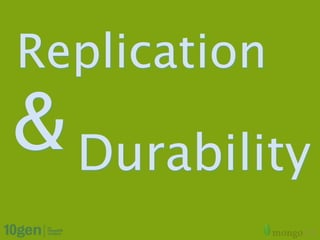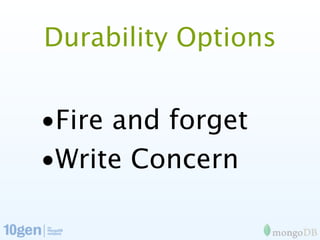The document discusses the concepts of replication and durability in MongoDB, detailing configuration, features, and scenarios for high availability and fault tolerance. It covers the structure and management of replica sets, data replication methods, and various types of outages. Additionally, it highlights advanced features like priorities, tagging, and durability options within different replication contexts.































![Creating a Replica Set
$ ./mongod --replSet <name>
> cfg = {
_id : "<name>",
members : [
{ _id : 0, host : "sf1.acme.com" },
{ _id : 1, host : "sf2.acme.com" },
{ _id : 2, host : "sf3.acme.com" }
]
}
> use admin
> rs.initiate(cfg)](https://image.slidesharecdn.com/replicationanddurability-green-120625063411-phpapp02/85/Replication-Durability-and-Disaster-Recovery-32-320.jpg)










































![Tagging - example
{
_id : "someSet",
members : [
{_id : 0, host : "A", tags : {"dc": "ny"}},
{_id : 1, host : "B", tags : {"dc": "ny"}},
{_id : 2, host : "C", tags : {"dc": "sf"}},
{_id : 3, host : "D", tags : {"dc": "sf"}},
{_id : 4, host : "E", tags : {"dc": "cloud"}}
]
settings : {
getLastErrorModes : {
veryImportant : {"dc" : 3},
sortOfImportant : {"dc" : 2}
}
}
}](https://image.slidesharecdn.com/replicationanddurability-green-120625063411-phpapp02/85/Replication-Durability-and-Disaster-Recovery-75-320.jpg)










